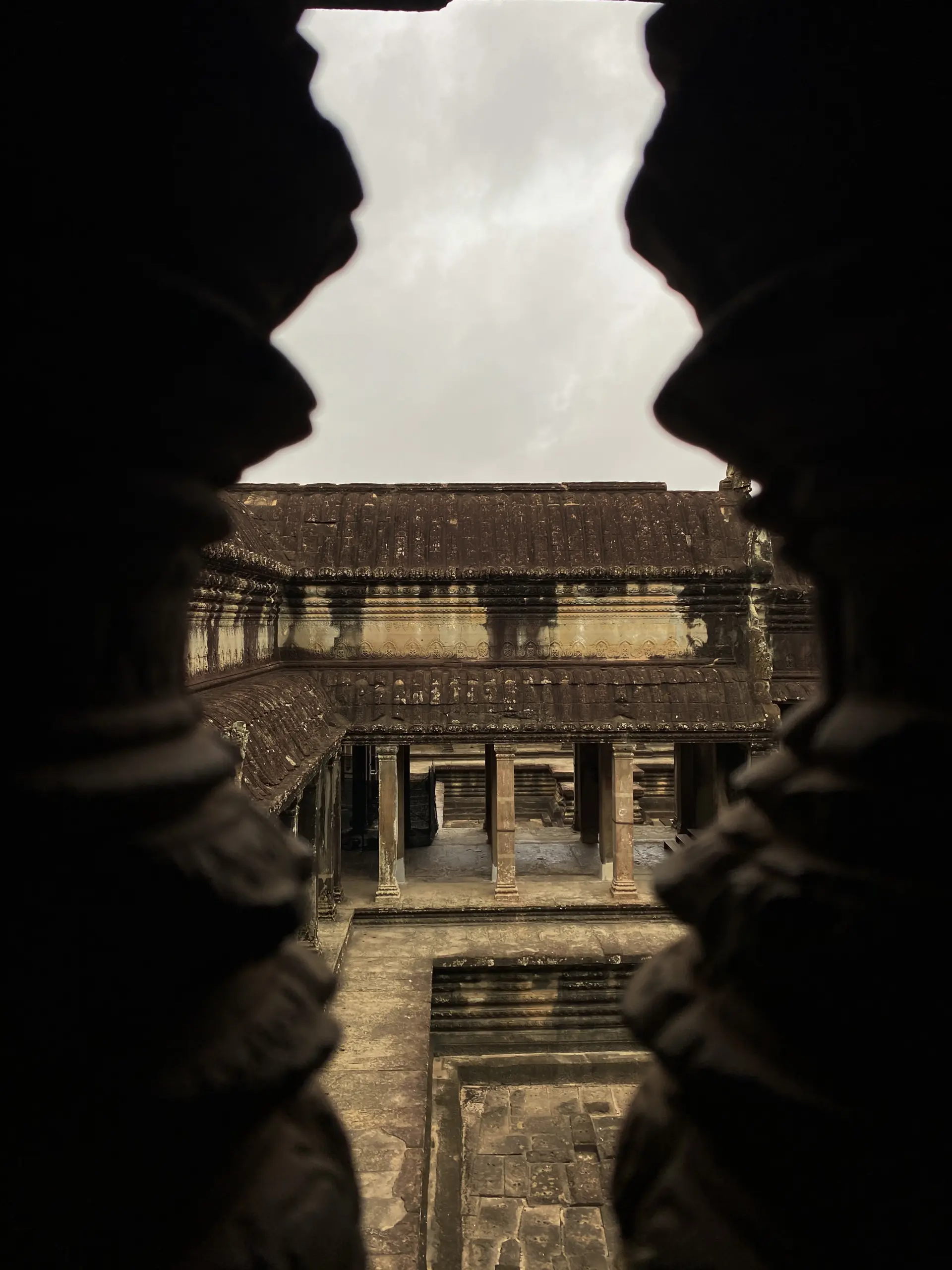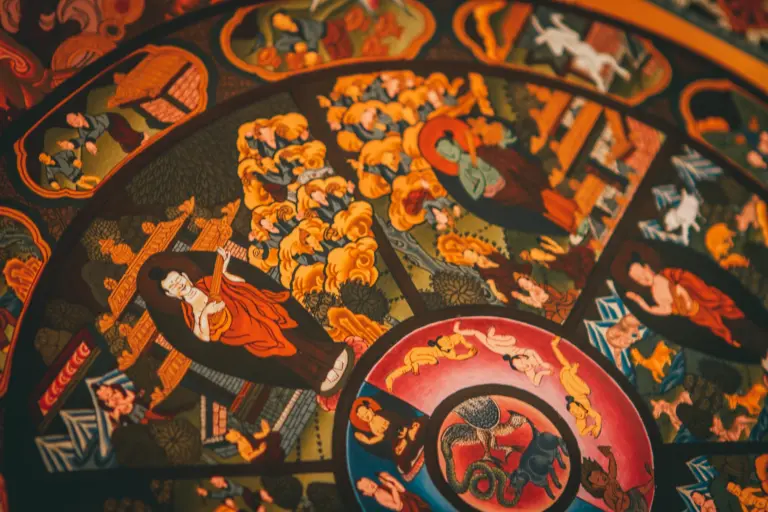Our spiritual journey in this article aims to explore three profound states of consciousness: Buddha Consciousness, Christ Consciousness, and Krishna Consciousness.
These states, deeply rooted in their respective traditions, represent not just religious concepts but unique spiritual awakenings that followers aspire to attain.
They encapsulate the teachings, virtues, and spiritual truths championed by Buddha, Jesus Christ, and Krishna.
A huge disclaimer is that this exploration does not serve to juxtapose one consciousness against the other. Instead, it offers a more thorough understanding where each path complements the other, enhancing the collective beauty and wisdom.
Through this journey, we seek not only knowledge but also an enriched appreciation of these spiritual states, providing pathways for us to find resonance, inspiration, and perhaps, a deeper purpose in our spiritual quests.
Table of Contents
ToggleWhat is Consciousness?
Consciousness, in its broadest sense, pertains to the state of being aware of the external environment, internal thoughts, and emotions.
Within a spiritual paradigm, however, consciousness goes deeper—it transcends wakefulness to encompass profound awareness of the unity of all life, the underlying spiritual truths of existence, and one’s true essence beyond the physical and mental constructs.
This heightened consciousness provides insights into realities that lie beyond the material, leading to transformative spiritual experiences.
Spiritual consciousness is not just about understanding but about experiencing. It’s about shedding the layers of one’s ego, misconceptions, and worldly distractions, to truly touch the essence of existence and the divine.
Every spiritual tradition has its depiction of this advanced state of consciousness, symbolizing a realization of the Divine.

Buddha Consciousness
The journey towards Buddha Consciousness is a sojourn into the very heart of Buddhism—a quest to attain the state of perfect enlightenment, known as Nirvana.
To truly comprehend this profound state of being, we must understand the core teachings of Siddhartha Gautama, the Buddha, and the rich wisdom he bestowed upon the world.
Enlightenment
In Buddhism, enlightenment, or Bodhi, is a transformative realization where ignorance is dispelled, and true knowledge arises. It is the awakening to ultimate truth, unshackling the chains of suffering and rebirth, and experiencing pure, unblemished consciousness.
This enlightenment isn’t a destination but a journey of understanding the Four Noble Truths:
- The existence of suffering (Dukkha)
- The cause of suffering, rooted in desire and attachment
- The cessation of suffering
- The path leading to the cessation of suffering, known as the Noble Eightfold Path.
The enlightened state, therefore, isn’t about escaping reality but fully understanding it. It’s about seeing the world in its raw, unfiltered essence, free from the veils of illusion, desire, and ignorance.
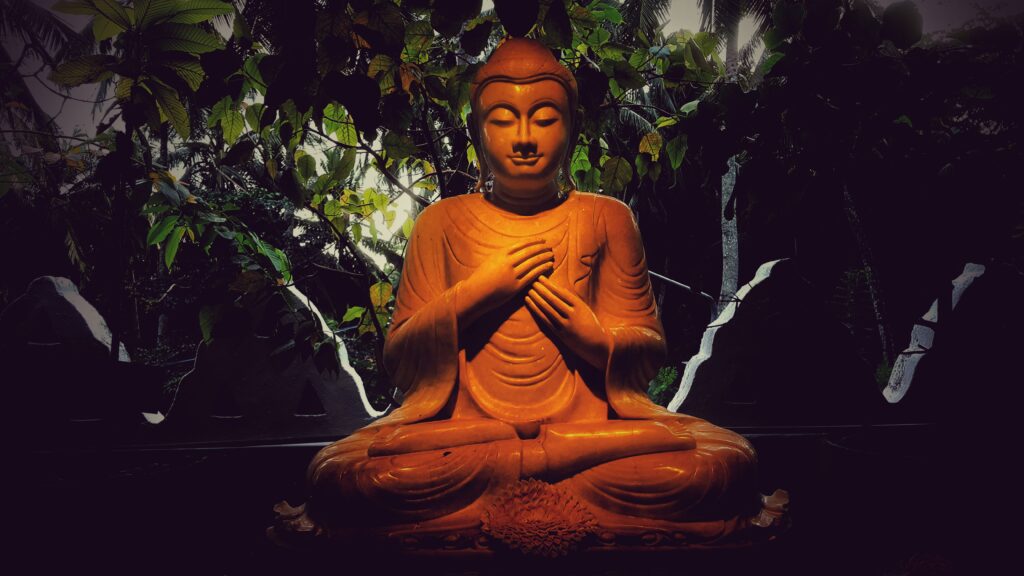
Anatta (Non-Self)
Central to Buddha Consciousness is the principle of Anatta or non-self. It challenges one of the most deeply ingrained beliefs—that of a permanent, unchanging soul. Instead, Buddhism teaches that what we perceive as “self” is merely a transient, ever-changing cluster of physical and mental components. Basically, Buddhism believes everything is inherently empty (Sunyata).
Diving deeper into Anatta, one uncovers the Five Aggregates (Skandhas), which are the constituent elements that come together to form the perception of self:
- Form (Rupa): The physical body and its senses.
- Sensation (Vedana): Feelings and responses to external stimuli.
- Perception (Samjna): The process of recognizing and naming objects.
- Mental Formations (Sankhara): Our habits, tendencies, and conditioning.
- Consciousness (Vijnana): The awareness of an object and its distinguishing aspects.
The understanding of Anatta reveals that these aggregates are impermanent, interdependent, and continuously evolving. Holding onto the belief in a fixed self leads to suffering, as we grapple with change, loss, and the inevitable reality of impermanence.
By embracing the concept of non-self, one transcends the confines of ego, attachment, and identity, paving the way to Buddha Consciousness and the bliss of Nirvana.
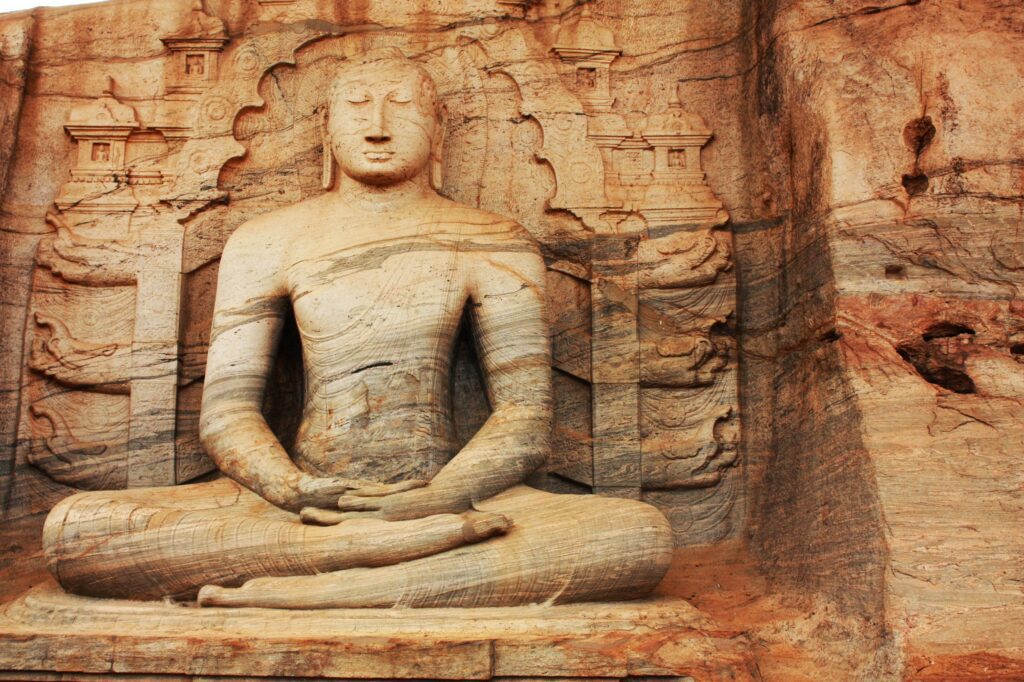
Characteristics of Buddha Consciousness
In the realm of Buddha Consciousness, one doesn’t merely understand Buddhist teachings; they embody them.
This embodiment reflects a myriad of profound characteristics, distinguishing those who have touched this elevated state of awareness.
1. Transcending the Ego
The ego, often defined as the “I” or “self” in psychological and spiritual discourse, is a complex construct that revolves around identity, self-importance, and differentiation from others.
It’s the ego that leads to desires, aversions, jealousy, pride, and a multitude of other emotions that tether us to the cycle of suffering.
Buddha Consciousness signifies a transcendence of this ego. In this state:
- The divisive lines between “I” and “other” blur, leading to a deep sense of oneness with all of existence.
- The incessant need for validation, the quest for superiority, and the fear of inferiority dissolve.
- One operates not from a space of self-centered desires but from a profound understanding of interconnectedness and compassion.

2. Realization of the Impermanent Nature of Reality
Everything in the world is in flux; this is the core tenet of the Buddhist concept of Anicca or impermanence. Attaining Buddha Consciousness means fully realizing, accepting, and embracing this truth. Such people who do:
- Witness the ebb and flow of life without desperate clinging. Whether it’s joy, sorrow, gain, loss, birth, or death, everything is seen as a transient phase in the grand scheme of existence.
- Find liberation in the knowledge that even suffering is temporary, and thus they remain unswayed by life’s ups and downs.
- Cultivate a deep appreciation for the present moment, understanding that it’s the only true reality.

3. Experiencing Inner Peace and Equanimity
Equanimity, or Upekkha, is a profound sense of calm and balance, undisturbed by external events, emotions, or thoughts. In Buddha Consciousness:
- Inner peace isn’t just a fleeting state but a steadfast anchor. It’s a serene core that remains untouched, even amid life’s fiercest storms.
- One’s reactions are not dictated by external circumstances but stem from deep wisdom and understanding. Pleasure doesn’t lead to reckless elation, and pain doesn’t result in debilitating sorrow.
- This equanimity is not necessarily indifference. Instead, it’s a balanced response, a middle way that Buddha emphasized, where one engages with life fully but without being enslaved by it.

Achieving Buddha Consciousness
While Buddha Consciousness is a profound state of enlightenment, it isn’t reserved for the select few.
The teachings of the Buddha lay down a path that, when embraced with dedication and sincerity, can guide any seeker towards this transformative awakening.
This is achieved through practicing meditation, mindfulness, and living ethically which the Buddha has also graciously give guidelines to in the form of the Noble Eightfold Path:
Right Understanding (Samma Ditthi): Grasping the true nature of reality, understanding the Four Noble Truths, and the principles of Anicca, Dukkha, and Anatta.
Right Intention (Samma Sankappa): Cultivating intentions of renunciation, goodwill, and harmlessness.
Right Speech (Samma Vaca): Speaking truthfully, harmoniously, and kindly, avoiding slander, gossip, and harmful speech.
Right Action (Samma Kammanta): Acting in ways that do not harm others, refraining from stealing, killing, and misconduct.
Right Livelihood (Samma Ajiva): Engaging in professions that do not harm or exploit others.
Right Effort (Samma Vayama): Cultivating positive states of mind and releasing negative ones.
Right Mindfulness (Samma Sati): Being diligently aware of the body, feelings, mind, and mental qualities.
Right Concentration (Samma Samadhi): Developing the mental focus necessary for deep meditation.

Christ Consciousness
The term “Christ Consciousness” isn’t strictly biblical, but it has been used in various spiritual and metaphysical traditions to describe a state of consciousness where the individual feels a deep and intimate unity with God, much in the way Jesus Christ did.
It speaks to the aspiration to live and express the same unconditional love, compassion, and unity that Jesus embodied and taught.
Universal Love and Unity with God
Christ Consciousness is an elevation of awareness where one transcends the ego-driven self to become an embodiment of divine love and light.
Just as Jesus’s teachings centered on love—for God, for one’s neighbors, and even for one’s enemies—achieving Christ Consciousness means radiating that same boundless, unconditional love to all beings.
In John 10:30, Jesus declares, “I and the Father are one.” It’s this unity, where the individual feels inseparable from the Divine, that defines Christ Consciousness.
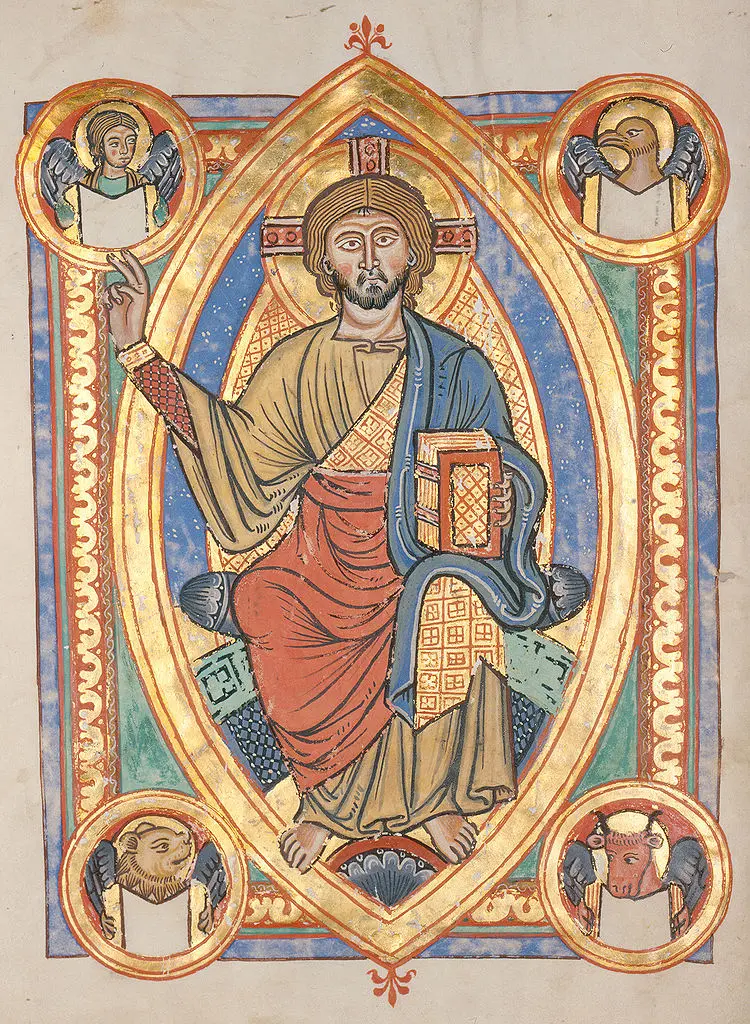
Embodying the Kingdom of Heaven
Jesus often spoke of the “Kingdom of Heaven” though it isn’t a distant paradise one might often think, but rather it’s a state of being, an inner realm of divine grace, peace, and joy.
The Kingdom of Heaven is not a future promise but a present reality for those who choose to live in conscious alignment with divine principles. Though you can also most certainly interpret it as the former.
The Kingdom of Heaven is inhabited by those who serve others selflessly, reflecting the essence of Jesus’s teachings: “Just as the Son of Man did not come to be served, but to serve” (Matthew 20:28).
Characteristics of Christ Consciousness
Embodied by Jesus and epitomized in His teachings, Christ Consciousness is a state of heightened spiritual awareness that brings one closer to the essence of Divine Love. This expanded state of consciousness manifests several key characteristics:

1. Unconditional Love
At the heart of Christ Consciousness lies a profound, unwavering love, mirroring the love that Jesus demonstrated throughout His life.
Just as Jesus showed compassion to the sinners, the outcasts, and the suffering, Christ Consciousness means to embrace all beings with a heart devoid of judgment.
One of the most revered teachings of Jesus was His emphasis on forgiveness. “Father, forgive them, for they do not know what they are doing” (Luke 23:34), He said, even as He was crucified. This unconditional forgiveness is a hallmark of Christ Consciousness.
2. Inner Purity over External Religious Practices
While Jesus was born into a religious setting, His teachings often went beyond traditional practices, emphasizing the purity of the heart over external observances.
Jesus often criticized the Pharisees for their overt religiosity devoid of genuine love and compassion. Christ Consciousness places more emphasis on the state of one’s heart and intentions rather than just external religious practices.
It’s not about merely following a set of religious rules but undergoing an inner transformation. This is beautifully encapsulated in Jesus’s teaching: “The kingdom of God is within you” (Luke 17:21).

Achieving Christ Consciousness
While the divine essence of this consciousness is often considered innate, aligning oneself with it requires intentional effort, unwavering faith, and an open heart.
Deepening one’s faith and placing trust in the unseen is a foundational element in achieving Christ Consciousness. When we believe in a higher plan and purpose, we’re more likely to surrender our ego-driven desires and align with a divine blueprint.
Prayer or regular communication with God, whether in moments of joy or adversity, nurtures the bond and reinforces faith. It’s a heart-to-heart conversation, where one expresses gratitude, seeks guidance, and finds solace.
The Sermon on the Mount, as recorded in the Gospel of Matthew (chapters 5-7), actually offers a roadmap to living a life aligned with Christ Consciousness.
The Eight Beatitudes, for instance can serve as a spiritual guide. These blessed teachings lay down the virtues and attributes of those living in Christ Consciousness. They emphasize humility, mercy, purity of heart, and a thirst for righteousness.
Plus, let’s not forget that Jesus stated, “Whatever you did for one of the least of these brothers and sisters of mine, you did for me” (Matthew 25:40). Recognizing the divine essence in everyone fosters genuine compassion and empathy.
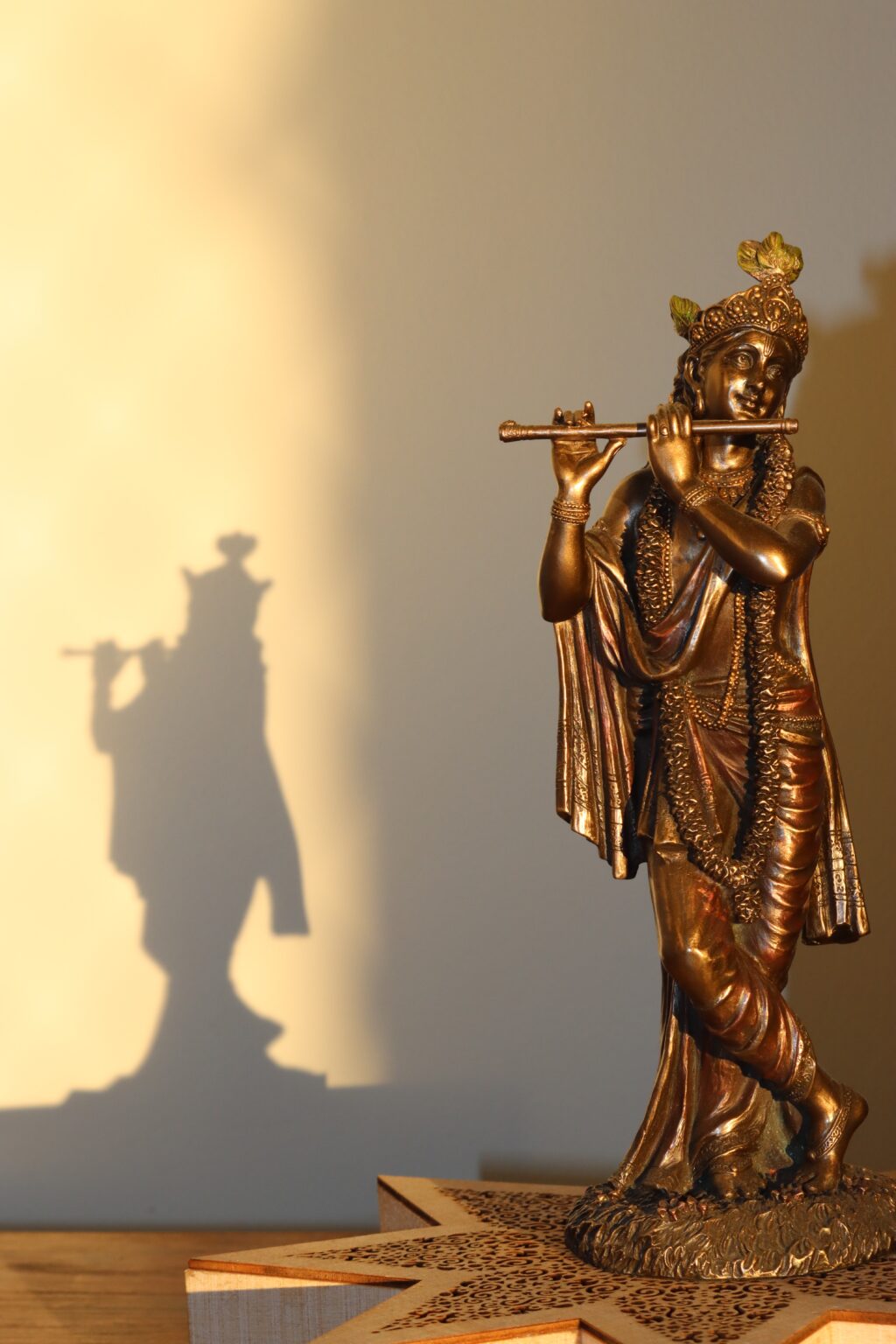
Krishna Consciousness
Krishna Consciousness is a term that captures the essence of a spiritual path centered around Lord Krishna, one of the most celebrated deities in Hinduism.
Historically, Lord Krishna’s teachings, stories, and philosophies have influenced millions of souls around the world. Often depicted as a flute-playing deity surrounded by nature and devotees, His divine play (lila) and teachings, primarily from the Bhagavad Gita, serve as a spiritual compass for many.
Krishna Consciousness, in its purest form, signifies an inner awakening to the divine presence of Sri Krishna in one’s heart and in the cosmos. It’s an ever-deepening realization of the intimate relationship between the individual soul (jivatma) and the Supreme Soul (paramatma) which is what’s come to be known as Brahman.
Bhakti Yoga
At the core of Krishna Consciousness is Bhakti Yoga (this is different from the common physical conception of yoga), the spiritual path of pure love and devotion. It’s an unwavering commitment and surrender to Krishna, where one seeks to experience the Divine not as an external entity, but as a living presence within and everywhere.
The Eternal Play of the Divine
In Krishna Consciousness, life is perceived as a divine dance where the soul partakes in the eternal play orchestrated by Krishna. Every moment becomes an act of divine significance, and every experience is seen as a play of the Divine.
Krishna’s life on Earth is seen as a series of divine play or lilas. These are eternal truths, symbolic representations of spiritual truths, and a means for devotees to deepen their love and connection with Krishna.
Every lila of Krishna, be it His playful antics as a child or His profound teachings in the Bhagavad Gita, is considered transcendental – beyond the mundane, infused with divine energy and lessons.
Characteristics of Krishna Consciousness

1. Pure Love and Devotion
Central to Krishna Consciousness is Bhakti, an unyielding, pure devotion to Lord Krishna. Krishna Consciousness signifies an intimate, profound relationship with Lord Krishna. In this state, every act, every thought, and every emotion becomes a heartfelt offering of love to the divine.
The enchanting sounds of Krishna playing his flute, the soul-stirring renditions of bhajans, and the communal energy of kirtans (devotional songs) encapsulate this devotion, pulling the devotee’s soul closer to Krishna’s essence.
The tales of Krishna also serve a dual purpose: Whether it’s the Bhagavad Gita or the Mahabharata, they provide invaluable spiritual teachings and continuously deepen the profound bond of love and reverence between the devotee and the deity.
2. Recognizing the Divine in All Things
In the realm of Krishna Consciousness, the divine’s omnipresence becomes palpable in every facet of existence.
Everything, from the towering mountains to the tiniest of creatures, becomes a part of Krishna’s divine play, underlining His omnipresence in creation.
Recognizing the divine spark within every life form, individuals deeply rooted in Krishna Consciousness inherently respect all living beings, leading to non-violence (ahimsa) and compassion in thought, word, and deed.
In fact, life’s trials and joys are perceived as part of the lila orchestrated by Krishna. This perspective instills a serene acceptance of life’s circumstances and a deeper understanding of one’s place in the grand scheme of things.

3. Ananda
Ananda, or divine bliss, becomes a defining experience for those deeply entrenched in Krishna Consciousness.
Beyond fleeting pleasures and transient joys, those in Krishna Consciousness tap into a wellspring of eternal happiness, drawing from their intimate connection with Krishna.

Achieving Krishna Consciousness
Journeying towards Krishna Consciousness uplifts the spirit, aligning it with divine love and devotion. Rooted in ancient Vedic traditions, the pathway to Krishna Consciousness encompasses various practices, each contributing towards spiritual growth and enlightenment.
One of these is mantra chanting.
The repetitive chanting of sacred mantras is believed to purify the heart and mind, attracting divine energies.
And of course, one cannot mention Krishna without the Hare Krishna mantra.
“Hare Krishna, Hare Krishna, Krishna Krishna, Hare Hare, Hare Rama, Hare Rama, Rama Rama, Hare Hare”
This mantra is a 16-word Vaishnava mantra that invokes the divine energies of Lord Krishna and Lord Rama (from the holy story of Ramayana, both Krishna and Rama are avatars of Vishnu). Regular chanting is believed to awaken love for Krishna and free the soul from the cycle of birth and death.
Using a set of prayer beads (japa mala), devotees often engage in meditative mantra repetition. Each round consists of 108 beads, symbolizing the 108 gopis of Vrindavan.
Finally, one can also read and understand the Bhagavad Gita. Often referred to as the spiritual gem of India, the Gita is a 700-verse conversation between Arjuna and Lord Krishna. Its teachings on duty, righteousness, and devotion are timeless and universal.
Buddha vs Jesus vs Krishna Consciousness
Similarities
Despite emerging from different religious traditions, all three forms of consciousness converge on several key spiritual principles:
1. The Ultimate Goal of Union with the Divine
Buddha Consciousness: While not centered around a deity, it aims for Nirvana, an ultimate state of liberation and union with the universal truth, transcending worldly suffering.
Christ Consciousness: It highlights a deep connection with God, achieved through love and service. Jesus’s life exemplified this union as He consistently aligned His will with that of the Father.
Krishna Consciousness: Followers seek to merge their individual consciousness with Krishna’s divine consciousness through unwavering devotion and love.

2. Transcending the Ego and Worldy Attachments
Buddha Consciousness: Central to Buddhist teachings is the idea of “Anatta” or no-self. It emphasizes the impermanence of the ego and the material world.
Christ Consciousness: Jesus taught about dying to oneself to attain true spiritual life, implying the transcendence of the ego and the relinquishment of material desires.
Krishna Consciousness: The Bhagavad Gita stresses the ephemeral nature of life and advocates for performing duties without attachment to outcomes.
3. Emphasizing Love, Compassion, and Ethical Living
Buddha Consciousness: Buddha’s teachings underscore the significance of Metta (loving-kindness) and compassion. Living ethically is foundational to the Eightfold Path.
Christ Consciousness: Jesus’s teachings are anchored in love—for God, for neighbors, and even for enemies. Ethical living and compassion are emphasized throughout the New Testament.
Krishna Consciousness: Love and devotion (bhakti) towards Lord Krishna are paramount. The Gita also outlines duties and ethical living as paths to achieving a higher consciousness.
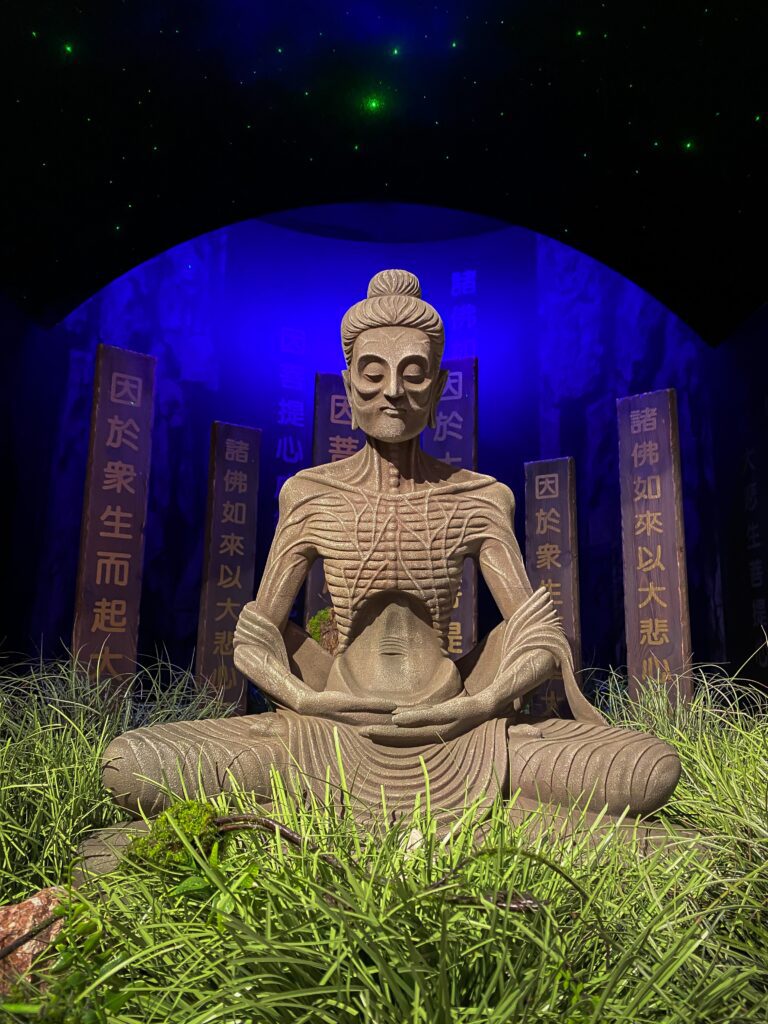
Differences
While the underlying aim of attaining heightened consciousness and union with the Divine is common, the paths of Buddha Consciousness, Christ Consciousness, and Krishna Consciousness differ in their methodologies, philosophies, and expressions. Let’s dive into some of these distinct characteristics:
1. Paths and Practices
Buddha Consciousness: This path is meticulously outlined in the Eightfold Path, which encompasses right view, intention, speech, action, livelihood, effort, mindfulness, and concentration. Meditation and mindfulness are pivotal practices, fostering awareness and clarity.
Christ Consciousness: The life and teachings of Jesus form the basis for this path. Emphasis is on prayer, faith, and acts of service. The Beatitudes from the Sermon on the Mount provide specific guidance on the attitudes and virtues that lead to spiritual growth.
Krishna Consciousness: Centered around unwavering devotion (bhakti) to Lord Krishna, this path heavily emphasizes chanting (especially the Hare Krishna mantra), temple worship, and devotional rituals. Engaging in selfless service and reading sacred texts, particularly the Bhagavad Gita, are also fundamental practices.

2. Views on the Divine
Buddha Consciousness: Unlike the other two, Buddha Consciousness doesn’t focus on a deity or God. Instead, it zeroes in on achieving Nirvana, a state beyond suffering and cyclical rebirths. The emphasis is on personal enlightenment and liberation from the cycle of samsara.
Christ Consciousness: Here, God is perceived as a loving Father, with Jesus Christ serving as a bridge between humanity and the Divine. The focus is on cultivating a personal, intimate relationship with God through Jesus and understanding the Holy Spirit’s indwelling presence within believers.
Krishna Consciousness: The Divine is personified in the form of Lord Krishna, considered the Supreme Personality of Godhead. Devotees aim to cultivate a deeply personal and devotional relationship with Krishna, viewing themselves as eternal servants and Krishna as the eternal master.

Implications for Modern Seekers
In an age marked by rapid technological advancement and an overwhelming influx of information, the timeless insights from these paths are more pertinent than ever.
Us modern seekers are often more interested in direct spiritual experiences than adhering strictly to religious dogmas. Both Buddha’s teachings and the emphasis on personal relationship with the Divine in Christ and Krishna Consciousness resonate with this inclination.
For instance, Buddha’s exhortation to not believe anything unless one personally experiences and validates it is highly relevant today.
In the end, true spiritual growth is reflected in one’s internal transformation rather than just external religious observances. The genuine change in one’s heart, mindset, and actions is the ultimate proof to one’s spiritual journey.
Perhaps like me, you may also be inclined to try out a syncretic approach. Just as many contemporary spiritual seekers are also drawing from multiple traditions to craft a path that resonates with their own unique spiritual inclinations.
Because nowadays, with the increased exposure to diverse spiritual traditions, there’s a growing understanding and respect for all paths.
Conclusion
While these paths emerge from different historical, cultural, and philosophical contexts, their core teachings offer invaluable insights for many.
By emphasizing personal experience, allowing adaptation of diverse practices, and focusing on the universal quest for awakening, they serve as guiding lights in today’s complex spiritual landscape.
Throughout the annals of history, humanity has embarked on diverse spiritual quests, seeking answers to life’s most profound mysteries.
Buddha Consciousness, Christ Consciousness, and Krishna Consciousness, while originating from distinct traditions, all echo an eternal truth: the interconnectedness of all spiritual paths.
Each of these revered states of consciousness illuminates facets of the same diamond of universal truth. No matter where you look, the underlying essence remains consistent – an aspiration towards unity with the Divine and an understanding of our higher purpose in this vast cosmic play.
So, instead of dwelling on the differences, emphasizing commonalities can foster mutual respect, understanding, and harmony among various spiritual groups.
It encourages a journey of exploration, reflection, and understanding. A journey where one doesn’t just rigidly adhere to a single doctrine but is open to glean wisdom from varied sources. It’s a call to experience the infinite shades of spirituality, to understand that every path, in essence, leads to the same luminous summit of Divine realization.
They remind us that, while our journeys might differ in the routes taken, our destination remains singular – a deep, abiding union with the Infinite.


